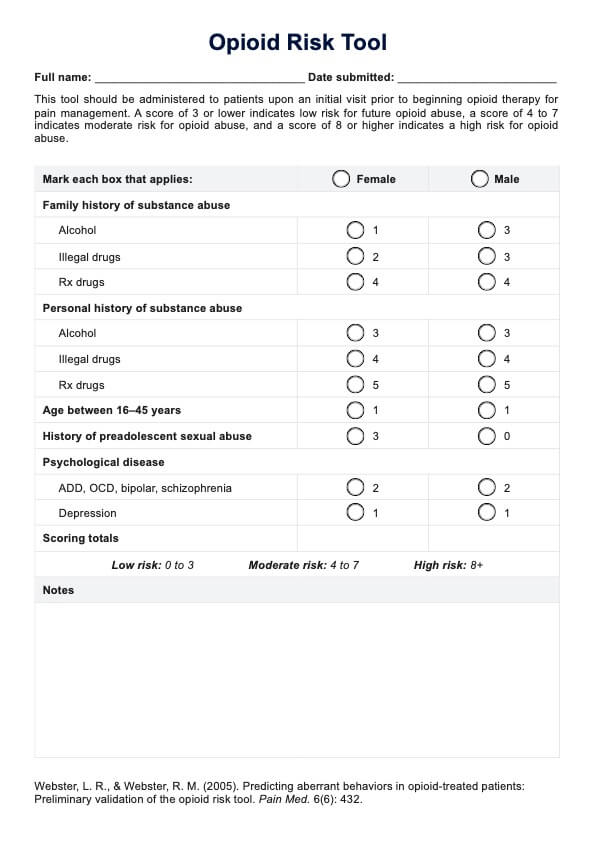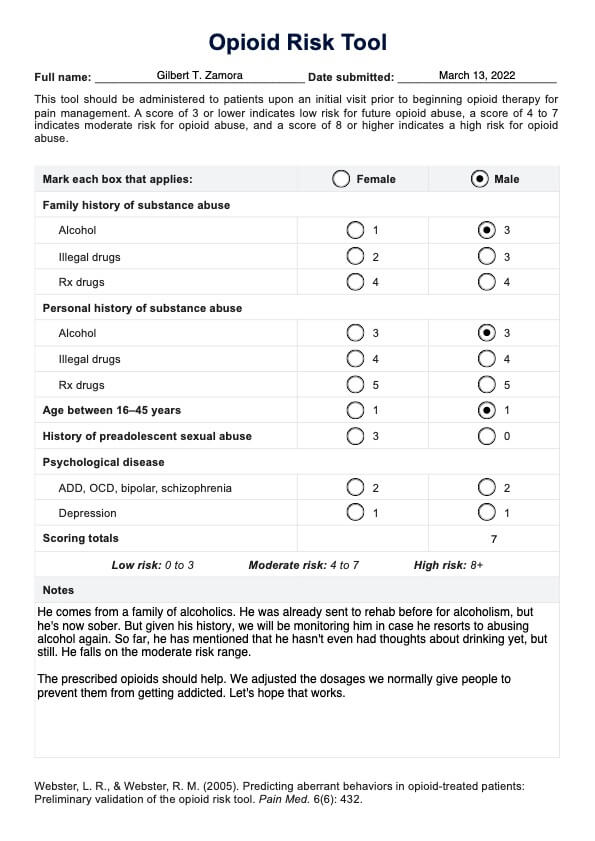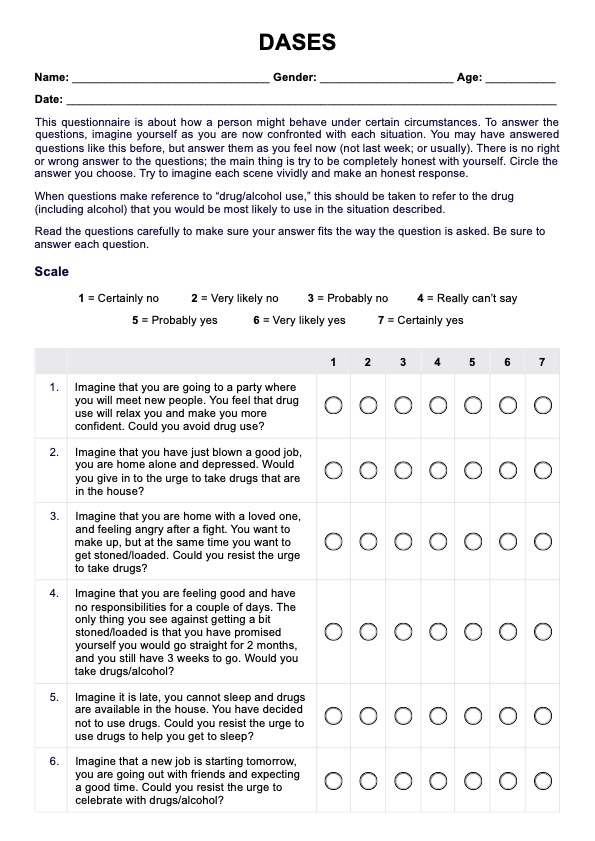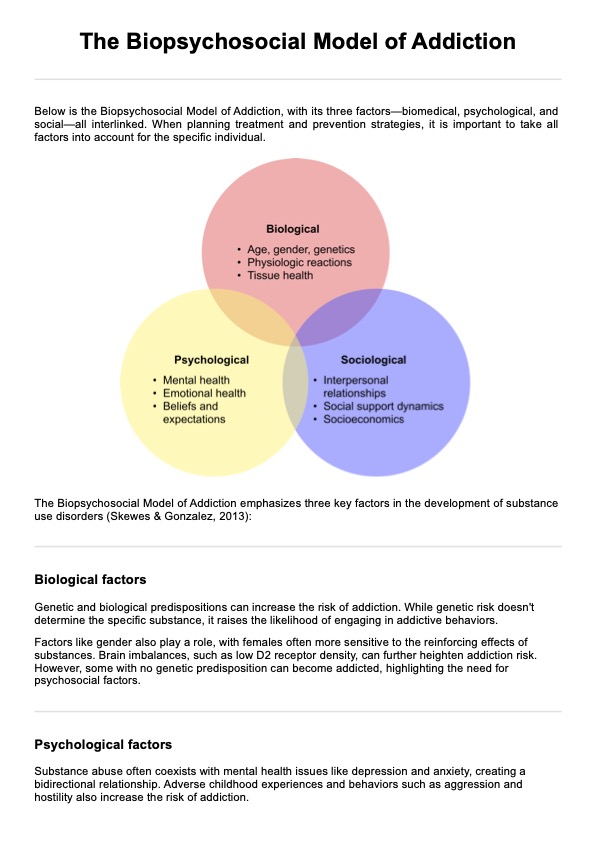Opioid Risk Tool (ORT)
Use the Opioid Risk Tool to determine the likeliness of a chronic pain patient developing opioid misuse disorder.


What is the Opioid Risk Tool (ORT)?
The Opioid Risk Tool, or ORT for short, is a nifty risk assessment tool created by Lynn R. Webster, MD. It was created to serve as a self-report screening tool to be used on patients who are about to take opioid therapy for chronic pain to see if they are at risk of developing opioid use disorder.
Chronic pain patients have a higher chance of prescription opioid misuse, substance abuse, alcohol abuse, and other things they can get their hands on to numb the pain they're feeling. Using the Opioid Risk Tool will help assess risk of addiction in opioid-treated patients so that doctors can develop ways to mitigate that risk and prevent them from developing aberrant drug-related behavior and engaging in prescription drug abuse or even illegal drug abuse.
How is the assessment scored, and how are the results interpreted?
The Opioid Risk Tool comes in the form of a list containing the following factors:
- Family history of substance abuse: alcohol, illegal drugs, prescription drugs
- Personal history of substance abuse: alcohol, illegal drugs, prescription drugs
- Age (if between 16 to 45)
- History of preadolescent sexual abuse
- Psychological disease: ADD, OCD, bipolar, schizophrenia (these 4 in one option); depression
There are two answer columns: female and male. The person answering the tool or the healthcare professional using it only needs to tick the necessary columns based on the patient's sex. The score for each answer may vary. One answer might score higher for a male than it would for a female, and vice versa.
After the tool has been completely answered, the healthcare professional needs to add up and get the sum of all the answers to get the total score. They can refer to the following score ranges to help them interpret the results:
- Low risk: 0 to 3
- Moderate risk: 4 to 7
- High risk: 8+
The only thing that healthcare professionals need to worry about is the possibility of the patients lying about their family and personal history of substance abuse and other factors, which can make predicting aberrant behaviors and potential opioid medication misuse a little tricky. It's best to explain the purpose of this tool to patients and assure them they're in a judgment-free zone and that you're here to help and cover all bases.
Next steps after using the ORT
The next step is to begin their prescribed opioid therapy while taking into account the results of the Opioid Risk Tool. The specific prescribed opioids and the dosages must be adjusted depending on a patient's risk level.
Healthcare professionals must also monitor chronic pain patients who are already taking opioid therapy for pain management and identify prescription medication misuse immediately to avoid the potential problems chronic opioid therapy may lead to, such as opioid abuse, myocardial infarctions, and sexual dysfunction. Rehabilitation plans must also be readied in case patients become dependent and addicted to the prescribed opioids.
Printable Opioid Risk Tool (ORT) Template
Printable Opioid Risk Tool (ORT) Example
How to use our Opioid Risk Tool (ORT) template
Using the Opioid Risk Tool (ORT) is easy! Regular versions of this tool will likely have the patient or healthcare professional encircle the specific factors applicable.
For our template, we added radio buttons for users to tick using a pen (if using a printed version) or the click of a mouse/tap (if using a digital version). There's an editable field below the columns for female and male to indicate the total score, and the score ranges are found below the total score section so professionals can easily see the risk ratings for patients.
How this tool benefits healthcare professionals
Here are some of the benefits of using this handy Opioid Risk Tool template:
It can help them formulate a dosage plan
As mentioned earlier, the purpose of the ORT is to determine the risk of a chronic pain patient becoming dependent or addicted to prescribed opioids based on their age, sex, family and personal histories of substance abuse, if they've experienced traumatic things when they were young (specifically sexual abuse), and if they have any mental health issues.
By knowing if these risk factors apply to their patient or not, they can decide on the specific opioids and the proper dosages for them to prevent or mitigate the risk of the patient developing dependence or addiction to the prescribed opioid.
This can help them monitor patients
If the patient's ORT score falls under moderate or high risk for prescribed opioid misuse, abuse, or dependence, this can help healthcare professionals determine how to go about monitoring patients and what rehabilitation measures they can possibly implement if the patient does become addicted to opioids as a result of their opioid therapy.
Commonly asked questions
No. It's best to use other assessments as well, especially when diagnosing substance abuse disorder and other related problems.
We added a notes box at the very end of our template. It would be best to ask patients questions about their answers so you can get as much information from them as possible to make a well-rounded treatment plan (and even a diagnosis, if you're making one).








































































































